The Dalmatian Club of America
FIFTEEN YEARS' DATA OF ALMOST
3,000 DALMATIAN URINARY STONES
Study Group on Urinary Stones Research
Committee Dalmatian Club of America
Introduction
The most common Dalmatian urinary stones are urates (also
classified as "purines") whereas the most common in all other breeds of
dogs is struvite (also known as "infection stones"). These two frequent
culprits of abnormal canine stone-forming spotlight the need to, first,
diagnostically confirm their presence so that subsequent treatment is not
incorrect and misdirected. For example, urates thrive in acidic urine whereas
infection stones thrive in alkaline urine and so, one treatment option
of acidifying or alkalinizing the urine could be either beneficial or detrimental
depending on the type of abnormal stone or crystals the Dalmatian is forming.
Breeders and fanciers now are reluctantly aware that every
one of our beloved breed is born with the potential of urate
stone-forming because of breed-specific defects of urine production in
Dalmatian livers and kidneys. I join with them in unhappily accepting this
deplorable fact which has been known and taught to veterinarians for 81
years. It is especially disturbing considering Dalmatians are the only
breed of dog with these inborn defects. Bulldogs, for example, also have
a high incidence of urate stone-forming but not for the reasons Dalmatians
do. Most breeders now are also aware of being able to minimize and even
prevent overt Dalmatian urate stone-forming by (1) reducing purine-yielding
foods in adult Dalmatian diets, (2) by monitoring via dipsticking to determine
and to correct abnormal urinary pH, and (3) by routine repetitive urinalyses
to detect the onset of abnormal urinary crystals before they progress into
stone formation and the dreaded urinary obstruction.
As recognition of this breed-specific health problem has
grown during these years, breeders inevitably ask, "If all Dalmatians
are born with the defect, how do we know which ones will shift from potential
stone-formers to overt ones?" The answer is no one knows nor is
any kind of data gathering even possible which could lead to plausible
suggestions. There simply are overwhelmingly too many factors influencing
overt stone-forming to be surveyed in order to come to any sort of statistically
significant trends from which to draw even preliminary answers to the question.
Yes, it is known that diet and perhaps the quality of local water purification
can be two influences to push the potential Dal into overt stone-forming
but lurking in the background and complicating any appraisal of a meaningful
database of Dalmatians are many other contributing factors, such as:
-
how often each Dal is permitted to void,
-
how "normally" concentrated its urine is,
-
in the case of show entries, how often it leaves its home
environment and to where,
-
how accurate was the identification of abnormal crystals
and stones (reported to be 65 percent in error according to a published
veterinarian survey of U.S. assay methods).
I personally am not convinced that breeding contributes to
overt stone-forming being that every Dalmatian, regardless of breedline,
is born with the defect. For example, the Study Group has received reports
of males as young as six weeks rupturing their bladders due to urinary
obstruction. These reports are erratic, thankfully rare but inconclusive
in terms of any postulated incidence within those breedlines after tracking
back into the sire's and dam's pedigree or with repeat breedings. The Study
Group has reports of adult Dalmatians (who had obstructed) becoming and
remaining symptom-free without recurrence of abnormal urinary crystals
by shifting diet, by anti-urate drugs and by changing water intake...but
tracking littermates of all such overt stone-formers much less littermates
of non-overt stone-formers for evaluation and comparison is an impossible
task. Some stone-forming sires and dams have produced litters in which
no puppies have subsequently been reported with abnormal crystals or urinary
obstruction. Other sires and dams without any history of abnormal crystals
or stone-forming have produced puppies who ultimately have been reported
as stone-formers. As a final example, the Study Group has reports on elderly
Dalmatians, previously symptom-free their entire lives, whose owners moved
into a new state and shortly thereafter, the Dalmatians obstructed for
the first time in their long lives. The influence of local environmental
factors cannot be dismissed therefore and would have to be evaluated nationally
as one more influence on overt stone-forming in any meaningful explanation.
And so, before any breed-wide conclusions can be drawn without jumping
to presumptive conclusions or without invalidly projecting observations
from a very few Dalmatians onto the entire breed, an exhaustive project
of data gathering would necessarily have to be completed. Anecdotal evidence
is useful, certainly better than nothing, but is remotely far from the
mandatory statistical significance for scientific conclusion.
I know some breeders claim "I have never had a stone-former
in my line." I sincerely and fervently wish this were so but what
they really should be saying is "I have never produced an overt
stone-former" - or - "I have never produced
a Dalmatian who has shown abnormal urate crystals." Until every
puppy of every litter tests with no abnormal urinary crystals, until those
puppies grow up to become adults and, regardless wherever they live and
whatever they're fed and whatever they drink, continue to
test without abnormal urinary crystals, an unequivocal statement "I
have never produced a stone-former" is open to question.
Perhaps in some future Dalmatian Utopia these insurmountable
discouragements will be overcome but until then, no meaningful conclusions
can even be suspected why some Dalmatians become overt stone-formers and
others do not. What we do have are the two U.S. veterinary
centers who specialize in canine stone-forming and from them, invaluable
statistics thoughtfully and cooperatively made available to the DCA Study
Group on Dalmatian stone-forming. In 1993, the Urinary Stone Analysis Laboratory
of the U. of California at Davis, and its chief, Gerald V. Ling, DVM, published
an article in the Journal of the American Veterinary Medicine Association
on a retrospective statistical analysis of 275 Dalmatian cases of stone-forming.
A bulletin was immediately issued to all regional DCA clubs with the pagination
of that article.
We now have, through the courtesy of Carl A. Osborne,
DVM, PhD, chief of the Minnesota Urolith Center of the U. of Minnesota
Veterinary School in St. Paul, the latest of their retrospective data on
almost 3,000 Dalmatian stones over the past fifteen years. The purpose
of this article is to brief the Dalmatian community on this latest statistical
compilation and to see if there were any changes in Dalmatian trends during
the past eleven years since Dr. Osborne published two 1986 volumes of a
veterinary teaching text on stone-forming. The following graphic data must
be qualified: readers should remember that the numbers, while statistically
significant, are those only of stones sent to Dr. Osborne's Minnesota Urolith
Center or only of stone-forming Dalmatians treated there. If the reader
projects the data into breedwide Dalmatian conclusions, they should remember
none of the data includes Dalmatians who were what Dr. Osborne terms "silent
stone formers" without symptoms or those whose stones were sent elsewhere
for assay. The graphic data provide invaluable information but within the
confines of confirmed stone-forming Dalmatians only.
Chart No. 1 - Dalmatians vs. OtherStone-Forming
Dog Breeds
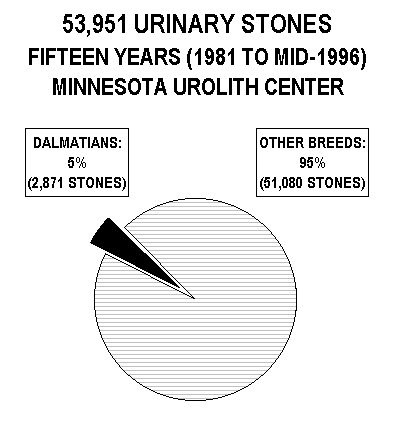
Three percent of all urinary stones reported by Dr. Osborne's
Center in 1986 were from Dalmatians. The current data shows an increase
to 5 percent but does not necessarily mean the health problem has ominously
increased within our breed. Teaching information during the past five years
from the DCA Study Group on Urinary Stones to the Dalmatian community has
urged abnormal urinary crystals or stones to be assayed by the Minnesota
or California centers because of the reported 65 percent error by local,
provincial testings. Therefore, it is entirely possible this increase in
the Dalmatian component mostly reflects more stones being supplied for
assay and not an increase in overt stone-forming in our breed.
Chart No. 2 - Site of Dalmatian Stonesin
Their Urinary System
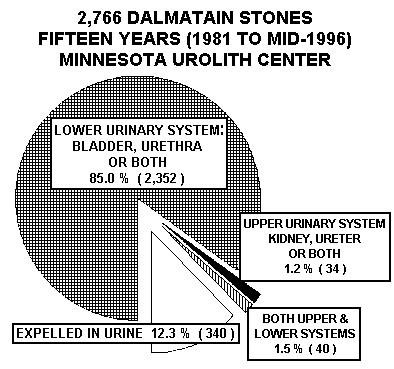
Some definitions, first - the "urethra" is the single
tube carrying urine from the bladder to the outside; the "ureters" are
bilateral tubes carrying urine from each of the kidneys to the bladder.
The lower urinary system (bladder, urethra or both) remains the most prevalent
location of stones as it was in Dr. Osborne's 1986 textbook statistics
(then grouped for all stone-forming breeds, Dalmatians included). By adding
in data on expelled stones, the sum means 97.3 percent of Dalmatian stones
are anatomically located in the lower system where many can be treated
non-surgically, easily and less expensively as compared to stones in the
upper urinary system.
The newly reported category of 12.3 percent Dalmatian
stones "passed" provides hope. The most common type of Dalmatian stone,
urates, architecturally tend to be rounded and smooth which facilitates
their moving down the urinary system as compared to other types of stones
which can be barbed and lodge more unmovingly. On a positive note, many
urate stones are reported as frequently being expelled and "passed." On
a negative note, large urate stones can be moved easily by the urinary
stream to jam within the penis at the narrowing of cartilage, the "os penis,"
thereby creating the dreaded urinary obstruction in males. If the Dalmatian
is obstructed, the smooth urate stones are equally capable of being similarly
and successfully moved to be "back flushed" into the bladder thereby re-opening
the urinary flow. A non-surgical attempt via diet and anti-urate medication
to dissolve urate stones thereby reducing their size so they can pass may
well be worth the effort, time and veterinary expense.
Renal surgery of the upper system (kidneys, ureters or
both) is major, drastic surgery requiring skilled experienced surgeons.
It may be prohibitively expensive whereas bladder surgery is no more complicated,
if unavoidable, than an appendix removal in humans. In 1986, stones in
the upper system of all breeds was 3 percent. These fifteen year data show
the upper system was confirmed in only 1.2% of Dalmatians and in both upper
and lower systems in 1.5 percent of Dals. Please note the data does not
identify which type of stones were lodged in the upper system of these
Dalmatians.
The total of 97.3 percent of stones in the lower system
is an eloquent explanation why indiscriminately calling the health problem
"Dalmatian kidney stones" is misleading and unnecessarily
threatening. The Study Group suggests it more properly be termed "Dalmatian
urinary
stones."
Chart No. 3 - Purines vs. Other Mineralsin
Dalmatian Stones
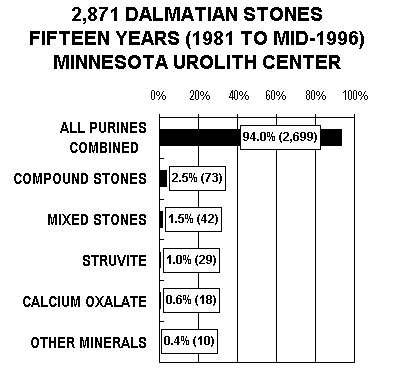
"Purine" stones include the most common mineral found
in Dalmatian stones, the "urates" of which there are several forms. It
is the urates which are automatically prognosed by many veterinarians to
be Dalmatian stones. The purine group also includes "xanthine." This purine
is a side effect of uninterrupted overdosage with the anti-urate drug,
allopurinol (see discussion under Chart No. 4). Unlike the other purines,
xanthine stones cannot be dissolved and must be removed surgically.
Knowing that Dalmatians do not metabolize purine-yielding
foods properly, it is not surprising that purine stones represent a whopping
94 percent of all Dalmatian stones assayed by Minnesota over the 15 year
period. A comparison of this stone - most common in Dalmatians - to struvite,
the most common one in all other breeds of dogs, is dramatic. In 1986,
Dr. Osborne's textbooks published a world survey of 1,700 stones from all
stone-forming breeds which showed struvite ("infection stones") to represent
63 percent whereas urate stones were identified from only 6 percent of
all breeds. In comparison, this graph shows the exact opposite of those
allbreed statistics - Dalmatians can indeed form the "infection stones"
but only 1 percent of Dalmatian stones were found to be struvite as compared
to 94 percent of Dalmatian stones confirmed as purines. Remembering that
Dalmatians are the only breed of dog with their type of urate stone-forming
defect, their reversal of the most frequently-found stone is not surprising.
However, it does not justify presuming any stone-forming Dalmatian is producing
urates despite their overwhelming preponderance. Identifying which abnormal
crystal or stone is being formed should not be avoided and still must routinely
be done before correct and successful treatment can be assured. Your overt
Dalmatian, for example, may just be forming struvite or calcium oxalate
stones.
Chart No. 4 - Breakdown of Types ofDalmatian
Purine Stones
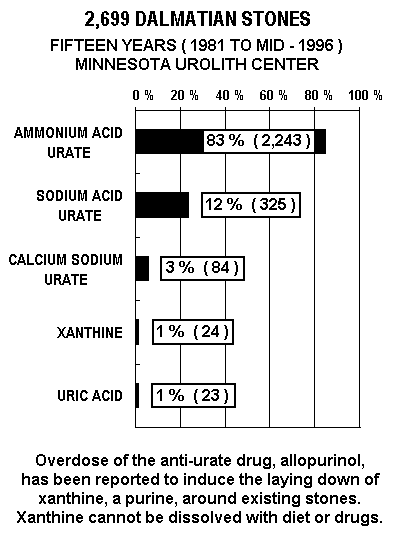
A monstrous 99 percent of Dalmatian purine stones - not
surprisingly because of the breed's defect - were the urates. Of those,
83 percent of stone-forming Dalmatians produced ammonium acid urate, a
form of urates happily very responsive to non-surgical treatment with anti-urate
diet and anti-urate medication. In 1986, only 80 percent of Dalmatian stones
were reported as urates, of which 76 percent were ammonium acid urate.
This increase, like Chart No. 1, may be a result of more Dalmatian specimens
being sent to Minnesota for assay. We may not know why some Dalmatians
become overt stone-formers but with this preponderance of those forming
urates,
we do know methods by which urates can be detected early in their onset
in order to be minimized and ultimate stone-forming avoided:
(1) dipsticking to detect as soon as possible an abnormally
acidic urine in which urates thrive, (2) urinalysis to confirm as soon
as possible the presence of abnormal urate crystals, (3) diet formulations
with low amounts of purine-yielding foods, including home cooked recipes,
(4) the anti-urate drug, allopurinol, in short periods of high dosage to
dissolve existing urates or in long-term low dosage for prevention, and
(5) the use of distilled water to guarantee fluid intake which does not
influence abnormal urinary crystals or stones.
Such early detection and the prompt starting of known
preventative methods can often minimize and reverse the ongoing growth
of urate stones in the urine thereby aborting the dreaded urinary obstruction.
Note the 1 percent of xanthine which shows up as a mineral
in the stones for the first time in these new data. It was only in 1991
that the report of xanthine as a side effect of allopurinol overdosage
was first published in the veterinary literature. Dalmatian stones consisting
of a center core of urates surrounded by outer layers of xanthine due to
allopurinol overdosage are extremely difficult to assay and require advanced
laboratory procedures like "high pressure liquid chromatography" available
at the two U.S. centers but rarely if ever for local, provincial assay.
Remembering the 65 percent error around the country in assaying any urinary
stone, it is quite possible that xanthine stones have existed for many
years but have never been identified. More importantly, it is then possible
that some previous failures attributed to non-surgical but unsuccessful
treatment with allopurinol of urate stone-forming in Dalmatians may have
been because of overdosage and the laying down of non-dissolvable xanthine.
Allopurinol still is reported to be the anti-urate drug-of-choice but its
dosage for long-term use to be knowledgeably prescribed.
Chart No. 5 - Gender of Stone-Forming
Dogs: All Breeds, All Minerals
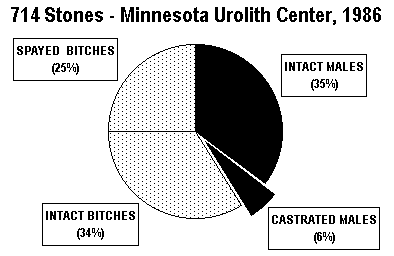
This chart of all breeds is included only as a comparison
to the next, Chart No. 6, representing only Dalmatian data. Note that because
all minerals are combined for this data, the chart includes that for struvite
("infection") stones, the most common one for all stone-forming breeds
of dogs except for Dalmatians. The preponderance of almost 60 percent bitches
perhaps may be a result of those struvite data because bitches are allegedly
more prone than males to urinary tract infections. While on the subject
of infection stones, it may be of interest to know that - of the bacterial
species known to frequently cause urinary tract infections - E. coli
is reported to be the most prevalent but it has not been incriminated as
a stone-forming bacterium. The others, Proteus and Staphylococcus
have been incriminated as stone-formers, such as "coagulase-positive Staphylococcus,
" for which Ampicillin has been reported to be the antibiotic-of-choice.
Chart No. 6 - Gender of Stone-FormingDalmatians
with Purine Stones
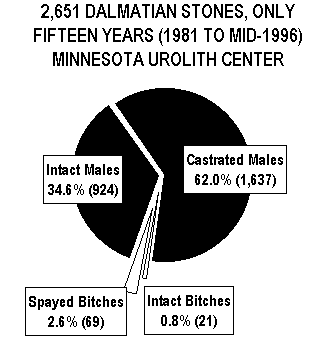
Compared to Chart No. 5, a gender shift to almost 97 percent
male Dalmatians may be explained because stone-forming symptoms and most
certainly urinary obstruction in males is immediately visible to the observer
as a result of their urinary anatomy. Bitches uneventfully pass many stones
including urates without detectable symptoms because their urinary anatomy
permit passing of large stones more easily than males. Many female stone-formers
therefore remain undetected and unreported but these data nonetheless dispel
the misconception that bitches do not become stone-formers.
Chart No. 7 - Age of Stone-Forming Dalmatians
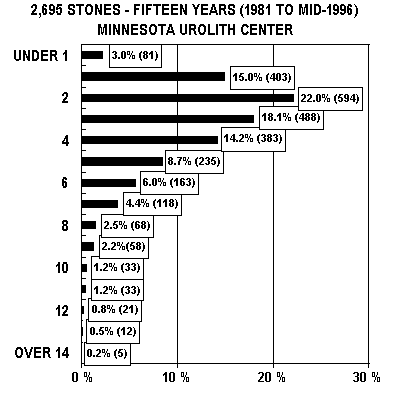
In 1986, Dr. Osborne's textbooks showed three years to
be the most prevalent age for all breeds to show stone-forming symptoms.
These current data shift to a range of one-to-four years as the most prevalent
Dalmatian ages. Younger Dalmatians now significantly showing up may be
a result of an increased awareness to the health problem and more frequent
observation of their urinating. Remember the prevalence of those ages merely
means when stones were sent to the Minnesota Center for assay or when the
dogs entered there as patients. We do not know how many of these data represent
the first onset of stone-forming.
The entire graph shows Dalmatian stone-forming can occur
at any age - in any puppy, in any adult and in older senior citizens. I
am not struck by the dwindling data after four years-of-age so much as
the mere presence of old Dalmatians in the data. Years or even a lifetime
of no overt stone-forming symptoms clearly does not justify complacency.
Chart No. 8 - Repetitive Stone-Formingby
the Same Dalmatian
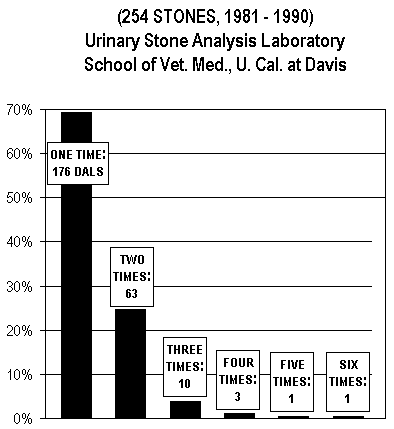
These data are not from Minnesota but from the California
ten-year database published in 1993. They logically follow Chart No. 7
showing age of stone-formers and are included to amplify those data for
you. Not surprisingly, the graph shows the majority of Dalmatians formed
stones in a once-or-twice pattern of recurrence. Thereafter, any Dalmatian
forming stones for a third-to-sixth time drops off precipitously. Several
possible explanations come to mind:
-
Repetitive stone-formers may have been euthanized the more
frequently they recurred;
-
Owners became more conscientious (and thereby more successful)
in following an anti-stone regimen;
-
New knowledge for successful treatment became available as
years went on;
-
Stones were not returned for assay as they recurred.
Summary & Conclusions
-
Every Dalmatian is born with the breed-specific potential
of urate stone-forming because of defects in urine production in the Dalmatian
liver and kidney. It is not known why some Dalmatians become overt stone-formers
as compared to others including littermates.
-
Improper diet containing potent purine-yielding foods or
large amounts of them have been incriminated in Dalmatian urate stone-forming.
Environmental factors such as quality of local water purification systems
may be an added, significant influence.
-
The vast majority of Dalmatian urinary stones reveal urates
as their most prevalent mineral as compared to struvite ("infection stones")
in all other breeds. This underscores the necessity to first identify what
kind of abnormal urinary crystal or stone the Dalmatian is forming before
effective and appropriate treatment can be dependable.
-
Architecturally, urates are smooth-walled so that treatment
directed to dissolving them for passing or to reopen blocked urinary flow
by non-surgical "back-flushing" carries hope for a high degree of success.
-
Male Dalmatians are susceptible to the dreaded urinary obstruction
but bitches have definitely been confirmed as stone-forming too.
-
Early detection of abnormal urinary crystals may be invaluable
to abort the progression into stones and their dreaded urinary obstruction.
The earliest sign can be an abnormal urinary pH easily monitored by Dalmatian
owners using dipsticks. The simple, inexpensive but confirming diagnosis
is a standard urinalysis to detect if abnormal urinary crystals are present
and continue to be present over repetitive testings. A published veterinary
survey revealed a 65 percent error in identifying abnormal urinary crystals
and stones throughout the U.S. Accordingly, the DCA Study Group on Urinary
Stones currently is working up a wallchart of abnormal urinary crystals,
planning on its distribution to their veterinarians by Dalmatian owners.
-
Overzealous and overly protective owners of Dalmatians
without
symptoms of abnormal urinary crystals or stones need not feel compelled
to adhere to the extremes of diet and water intake urged for known stone-formers.
The absence of symptoms, however, should be periodically confirmed by ongoing
urinalyses.
References:
Bartges, J.W., and coauthors: Prevalence of cystine and
urate uroliths in Bulldogs and urate uroliths in Dalmatians, Journal
of the American Veterinary Medicine Association 204: 1914-1918 (June
15) 1994.
Case, L.C., and coauthors: Urolithiasis in Dalmatians:
275 cases (1981-1990), Journal of the American Veterinary Medicine Association
203: 96-100 (July 1) 1993.
Ling, G.V., and others: Xanthine-containing urinary calculi
in dogs given allopurinol, Journal of the American Veterinary Medicine
Association 203:1933-1940 (June 1) 1991.
Osborne, C.A.: Data on some 3,000 Dalmatian stones, personal
communication.
Osborne, C.A., editor: Volume I, Canine Uroliths: Etiopathogenesis,
Detection, Treatment and Prevention, The Veterinary Clinics of North
America, W.B. Saunders Co., Publishers, Philadelphia, January 1986.
Osborne, C.A., editor: Volume II, Canine Urolithiasis,
The Veterinary Clinics of North America, W.B. Saunders Co., Publishers,
Philadelphia, March 1986.
Osborne, C.A., and coauthors: Analyzing the mineral composition
of uroliths from dogs, cats, horses, cattle, sheep, goats and pigs, Veterinary
Medicine 84:750-764, 1989.
Osborne, C.A. and others: Canine and feline urolithiasis:
Relationship of etiopathogenesis to treatment and prevention, in: Bojrab,
M.D., editor: Disease Mechanisms in Small Animal Surgery, Lea &
Febiger, Philadelphia, 1992.
Sorenson, J., and Ling, G.V.: A literature survey of urate
urolithiasis in Dalmatian dogs: Metabolic and genetic aspects, Journal
of the American Veterinary Medicine Association 203: 857-869 (Sept.
15) 1993.
A brochure summarizing information on Dalmatian stone-forming (including preventative and emergency procedures) is available free-of-charge for download: DCA Stone Pamphlet
Tracie Tepke, Director
This article was published originally in the Spring 1997 issue of the
SPOTTER, official publication of the Dalmatian Club of America, Inc.
Copyright © 1997, Dalmatian Club of America, Inc. All rights reserved.
|